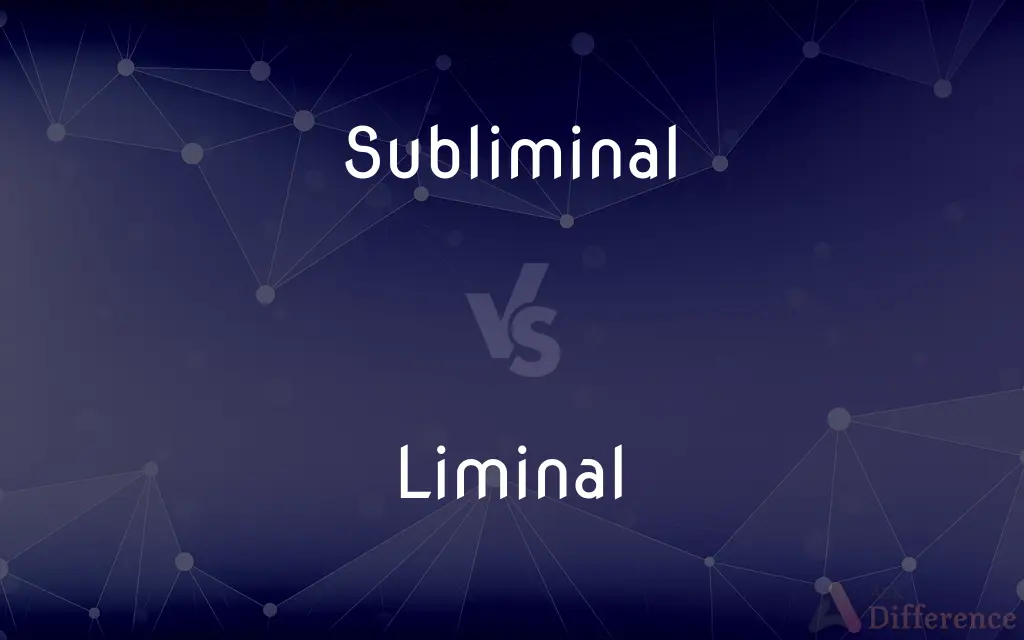Subliminal vs. Liminal — What's the Difference?
By Fiza Rafique & Maham Liaqat — Updated on April 28, 2024
Subliminal refers to stimuli or influences below the threshold of human consciousness, subtly affecting thoughts or behaviors, whereas liminal pertains to transitional or intermediate states, particularly those that are perceptible.

Difference Between Subliminal and Liminal
Table of Contents
ADVERTISEMENT
Key Differences
Subliminal stimuli are those that exist or operate below the threshold of conscious awareness, designed to influence behavior or perceptions without overt detection. On the other hand, liminal refers to something that is related to a threshold or boundary, often used to describe transitional or intermediate stages that are recognized and observed.
While subliminal messages might be embedded in media to subtly affect the audience's attitudes or actions without their conscious knowledge, liminal states are directly acknowledged and often integral to processes of change. Liminality is frequently explored in psychology and anthropology to describe periods of ambiguity and disorientation that occur during transitions.
Subliminal effects are typically employed in advertising, psychology, and neuroscience to examine how unnoticed stimuli can influence decision-making and preferences. In contrast, liminal phases are crucial in rituals, artistic narratives, and personal development, emphasizing awareness and growth during critical transitions.
An example of a subliminal influence is a barely audible or invisible message in an advertisement intended to sway consumer behavior. Conversely, a liminal example is the state of being in a graduation ceremony, which marks the transition from student to graduate, a clearly recognized and celebrated threshold.
The study of subliminal processes focuses on uncovering how unconscious elements affect cognition and behavior, whereas the study of liminal periods explores how conscious recognition of transitional phases influences personal and collective outcomes.
ADVERTISEMENT
Comparison Chart
Definition
Below the threshold of conscious awareness
Pertaining to a threshold or transition
Key Focus
Unnoticed influence
Recognized transition
Usage Contexts
Advertising, psychology
Anthropology, psychology, rituals
Examples
Hidden messages in ads
Rites of passage, graduation ceremonies
Influence on Behavior
Unconscious
Consciously transitional
Compare with Definitions
Subliminal
Operating below the level of consciousness.
Subliminal messages in music can influence mood.
Liminal
Pertaining to or situated at a sensory threshold.
Liminal visibility in the fog made driving hazardous.
Subliminal
Barely detectable but effective.
Subliminal stimuli in experiments often go unnoticed.
Liminal
Related to the initial stage of a process.
The artist's work explored liminal spaces between reality and imagination.
Subliminal
Impacting subtly and covertly.
Subliminal learning techniques can improve memory without conscious effort.
Liminal
Transitional or bordering between different states.
Adolescence is a liminal stage between childhood and adulthood.
Subliminal
Influencing the mind without conscious awareness.
The store used subliminal scents to enhance customer satisfaction.
Liminal
Marking a passage or transition.
The ritual served as a liminal phase marking the boy's entry into adulthood.
Subliminal
Involving hidden effects or messages.
He explored the impact of subliminal advertising on consumer choices.
Liminal
Involving disorienting phases of change.
The liminal period during corporate restructuring was challenging for employees.
Subliminal
Below the threshold of conscious perception. Used of stimuli.
Liminal
Intermediate between two states, conditions, or regions; transitional or indeterminate
"While doctors operate, she hangs suspended in the liminal space between life and death" (Jeremy Eichler).
Subliminal
Inadequate to produce conscious awareness but able to evoke a response
Subliminal propaganda.
Liminal
Existing at the limen. Used of stimuli.
Subliminal
(physiology) Of a stimulus: below the limen or threshold of conscious perception, especially if still able to produce a response; also (generally), below the threshold where a response can be produced.
Liminal
Of or pertaining to an entrance or threshold.
Subliminal
(psychology) Without directed awareness or thought; subconscious dated, unconscious.
Liminal
Of or pertaining to a beginning or first stage of a process.
Subliminal
(by extension) Of an advertisement, a message, etc.: conveyed in a manner that a person is unaware of being influenced by it.
Liminal
Of or pertaining to a limen, especially a sensory threshhold.
Subliminal
(physiology) Chiefly preceded by the: something which is below the limen or threshold of conscious perception.
Liminal
Marginally perceptible.
Subliminal
(psychology) Chiefly preceded by the: the subconscious dated or unconscious self.
Subliminal
(by extension) An advertisement, a message, etc., which is conveyed in a manner that a person is unaware of being influenced by it.
Subliminal
Existing in the mind, but below the surface or threshold of consciousness; that is, existing as feeling rather than as clear ideas.
Subliminal
Having or using an intensity of sensory stimulus insufficient to be perceived consciously, but having an effect on unconscious mental processes; as, subliminal advertising.
Subliminal
Below the threshold of conscious perception
Common Curiosities
How are subliminal stimuli used in marketing?
In marketing, subliminal stimuli may be used to create positive associations with a product or brand subtly.
Can subliminal messages truly influence behavior?
Yes, research suggests subliminal messages can subtly influence attitudes and behaviors without the individual's conscious awareness.
How can one become aware of subliminal influences?
Awareness of subliminal influences typically comes through education about these practices and techniques, such as learning how marketers use sensory cues.
What role does liminality play in cultural rituals?
Liminality is crucial in rituals as it represents a period of transition where participants are temporarily neither in their previous state nor in the one they are transitioning into.
How does liminality affect personal identity?
Liminality can profoundly affect personal identity, as it often involves reevaluating and reshaping one’s sense of self during transitions.
What are common examples of liminal experiences?
Common liminal experiences include graduating from school, transitioning jobs, or moving between cultures.
What are the potential benefits of recognizing and embracing liminal states?
Recognizing and embracing liminal states can lead to personal growth, deeper understanding, and improved resilience to change.
Are there ethical concerns associated with subliminal messaging?
Yes, the use of subliminal messaging raises ethical concerns, particularly regarding manipulation without consent.
Can liminal states be intentionally created or induced?
Yes, liminal states can be intentionally created in therapeutic, educational, or ritual contexts to facilitate growth and change.
Can subliminal techniques be used for personal development?
Yes, subliminal techniques can be used in areas like self-help and personal development to promote positive thinking and behavior changes.
How can one enhance their sensitivity to liminal phases in life?
Enhancing sensitivity to liminal phases involves mindfulness and reflection, recognizing the importance of transitions and their impact on life.
What is the significance of liminal spaces in architecture?
In architecture, liminal spaces, such as corridors or thresholds, are designed to transition smoothly between different areas, influencing how people experience and interact with spaces.
How is subliminal perception tested in psychology?
Subliminal perception is typically tested using techniques that limit the visibility or audibility of stimuli, ensuring they are below the threshold for conscious detection.
Are there any industries that particularly benefit from understanding liminality?
Industries like education, therapy, and human resources benefit from understanding liminality, as it aids in managing transitions and developmental stages effectively.
What are the differences in the use of subliminal and liminal concepts in art?
In art, subliminal concepts may be used to influence emotions subtly, while liminal concepts often explore themes of transformation and the in-between spaces of existence.
Share Your Discovery

Previous Comparison
Annihilate vs. Nihilism
Next Comparison
Subcategory vs. CategoryAuthor Spotlight
Written by
Fiza RafiqueFiza Rafique is a skilled content writer at AskDifference.com, where she meticulously refines and enhances written pieces. Drawing from her vast editorial expertise, Fiza ensures clarity, accuracy, and precision in every article. Passionate about language, she continually seeks to elevate the quality of content for readers worldwide.
Co-written by
Maham Liaqat













































